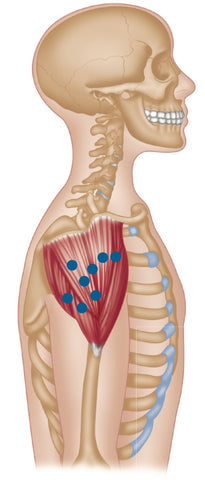Trigger Point Release - Dry Needling the Deltoid Muscle

The Deltoid Muscle
Pain in the Deltoids is most often mistaken for bursitis or a rotator cuff injury
Deltoid Anatomy and Trigger Points - Dr. Jonathan Kuttner
The deltoid, along with supraspinatus and associated rotator cuff muscles, will regularly develop myofascial trigger points as result of reduced core efficiency.
Failure to translate forces from the lower body to the shoulder will result in arthrokinematic stress and the formation of active myofascial trigger points.
The restoration of core neuromuscular efficiency will provide a foundation for myofascial trigger point therapy, utilizing neuromuscular therapy and medical exercise.
Pain is felt as a dull ache for the most part, with increased pain on contraction of the muscle or when attempts are made to move the arm.
Pain is most often mistaken for bursitis or rotator cuff injury. It is worthwhile checking the muscles that refer pain into the deltoid (SITS, pectorals, and scalenes) as the true source of deltoid pain.
Deltoid myofascial trigger points are more often than not satellite myofascial trigger points.

Deltoid - Common Trigger Point Sites

Dry Needling the Deltoid Muscle
Anatomy
The deltoid is composed of three parts: anterior, middle, and posterior. Only the middle part is multipennate, probably because its mechanical disadvantage of abduction of the shoulder joint requires extra strength.
Origin
Clavicle, acromion process, and spine of scapula.
Insertion
Deltoid tuberosity situated halfway down lateral surface of shaft of humerus.
Action
Anterior fibers: flex and medially rotate humerus.Middle fibers: abduct humerus at shoulder joint (only after the movement has been initiated by supraspinatus).
Posterior fibers: extend and laterally rotate humerus.Antagonist: latissimus dorsi.
Nerve
Axillary nerve, C5, 6, from posterior cord of brachial plexus.
Basic Functional Movement
Examples: reaching for something out to the side; raising arm to wave.
Trigger Point Referred Pain Patterns
Generally refer pain localized to trigger point and within a 5–10 cm zone.
Trigger Point Therapy Treatment Techniques
| Spray and Stretch | YES |
| Dry Needling | YES |
| Wet Needling | YES |
| Deep Stroking Massage | YES |
| Compression | YES |
| Muscle Energy Techniques | YES |
| Positional Release | YES |
Indications
Post-trauma rehabilitation, shoulder pain, decreased range of motion (especially in abduction), shoulder pain which worsens with motion and eases at rest, reduced range of motion and some loss of strength above 90 degrees.
Causes
Swimming, weight lifting, soccer (blows), basketball, jerky and vigorous repetitive movements, fishing, power tools, sudden blows, rifle rebound, skiing falls, injections into shoulder, dislocations, holding small baby.
Differential Diagnosis
Impingement syndromes. Sub-acromial bursitis. C5 radiculopathy. Rotator cuff tendinopathy. Osteoarthritis of glenohumeral or acromioclavicular joint.
Connections
Supraspinatus, infraspinatus, biceps brachii, teres minor, subscapularis, pectoralis major (clavicular head), rotator cuff issues, tendonitis, arthritis, C5 nerve issues, neck problems, often satellite trigger points from other problems (e.g. scalenes, pectoralis major), long head biceps brachii tendon problems.
Find a Trigger Point Professional in your area
More Articles About Shoulder Pain / Injuries
Dry Needling for Trigger Points
Certify as a Trigger Point Therapist

NAT Education Membership Plans from $19.95/monthly

NAT TRIGGER POINT THERAPY DIPLOMA COURSE
This trigger point therapy blog is intended to be used for information purposes only and is not intended to be used for medical diagnosis or treatment or to substitute for a medical diagnosis and/or treatment rendered or prescribed by a physician or competent healthcare professional. This information is designed as educational material, but should not be taken as a recommendation for treatment of any particular person or patient. Always consult your physician if you think you need treatment or if you feel unwell.

Continuing Professional Education
Looking for Massage Therapy CEUs, PT and ATC continuing education, chiropractic CE, or advanced manual therapy training? Explore our evidence-based online courses designed for hands-on professionals.


















